Natural Solutions for Unclogging Bathroom Drains
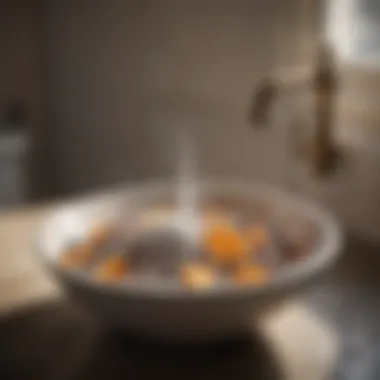
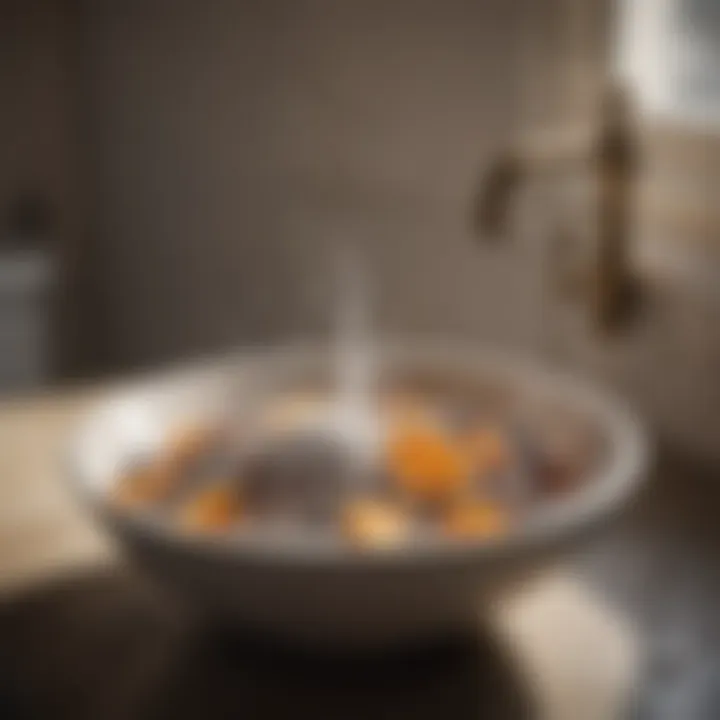
Intro
Dealing with a clogged bathroom drain can be a real headache. It's a common issue that most homeowners encounter at some point or another. Often, the go-to solution is to grab a bottle of harsh chemicals that promise to dissolve clogs in seconds. But what if you could achieve the same results using simple, eco-friendly ingredients found right in your kitchen? Baking soda and vinegar not only tackle clogs effectively but also keep your home fresh and safe. This article dives into the nitty-gritty of unclogging drains with these household staples, giving you the tools to manage clogs without resorting to toxic options.
The Science Behind It
Understanding how baking soda and vinegar work together can make all the difference. Baking soda is a basic (alkaline) compound that reacts vigorously with vinegar, which is acidic. When combined, they produce carbon dioxide bubbles, leading to agitation in the drain. This process can effectively dislodge debris and gunk that has built up, allowing water to flow freely again. The fizzing action serves not just to clear clogs but can also help deodorize your drains, leaving them smelling fresh.
Step-by-Step Guide to Unclogging
Unclogging your bathroom drain with baking soda and vinegar is simple. Here’s a step-by-step approach that anyone can follow:
- Gather Your Supplies
- Pour Hot Water
Begin by pouring a pot of hot (but not boiling) water down the drain to loosen up any build-up that's stuck in there. - Add Baking Soda
Next, dump about half a cup of baking soda directly into the drain. Let it sit for a few minutes to absorb moisture and grease. - Introduce Vinegar
Pour half a cup of white vinegar down the drain promptly after the baking soda. You should see fizzing and bubbling – that's normal. This reaction is crucial; it’s what helps break down the clog. - Cover the Drain
If you have a plunger, cover the drain with it. The pressure will help push the debris down and out of the way. If not, simply let the solution sit for about 15-30 minutes. - Flush with Hot Water
After waiting, pour another pot of hot water down the drain to flush out the residue. - Repeat If Necessary
Sometimes, tough clogs require a second round. Don’t hesitate to repeat the process or to use a drain snake if the problem persists.
- Baking soda
- White vinegar
- Hot water
- A plunger (optional, if you have a stubborn clog)
- A drain snake (for more serious blockages)
"Natural solutions are not just kind to the environment; they often prove to be just as effective as chemical cleaners."
Troubleshooting Persistent Clogs
Occasionally, a clog may be more stubborn than anticipated. Here are a few extra steps to consider:
- Use a Drain Snake: If the baking soda and vinegar combo doesn’t do the trick, a drain snake can help pull out hair and other debris.
- Check for Bends or Curves: Drains with sharp curves might snag materials, so keeping them clear is essential.
- Physical Removal: Sometimes, the best way is to remove the trap under the sink and clear it manually.
Preventative Maintenance
To keep bathroom drains running smoothly, consider these tips:
- Regular Cleaning: Use the baking soda and vinegar method monthly. This prevents build-up and keeps things flowing nicely.
- Hair Catchers: Installing hair catchers in your tub or shower drain can significantly reduce hair accumulation.
- Educate Family Members: Teach everyone in your household not to flush non-biodegradable items down the toilet, such as wipes or cotton swabs.
By implementing these methods and strategies, you can keep your bathroom drains free-flowing and reduce the need for unnecessary repairs. It’s a straightforward, effective process that aligns well with a healthier home environment.
Understanding the Problem of Clogged Drains
Clogged drains in the bathroom are more than just a nuisance; they can cause significant disruptions in everyday routines. Understanding why these clogs happen is key to effectively addressing them. It’s not simply about fixing what’s broken, but grasping the underlying issues contributing to these blockages. When you know the causes, you become better equipped to prevent future problems, making your home cleaner and more efficient.
Common Causes of Clogs in Bathroom Drains
Several factors can lead to clogged drains in bathrooms. Here are some notable culprits:
- Hair Accumulation: One of the primary causes in bathroom sinks and showers is hair. Each time we wash our hair or have a shower, strands can slip down the drain, gathering and binding together. Eventually, they create a stubborn blockage.
- Soap Residue: Many soaps, especially those that are rich or creamy, can leave behind residue that combines with the hair and grime in the pipes. This sticky buildup can trap other debris, escalating into a bigger problem.
- Toothpaste and Shaving Cream: These common grooming products are often easy to overlook. They can clog your drains, especially if they mix with hair or soap scum, forming a larger obstruction.
- Mineral Buildup: Hard water contains minerals that can accumulate inside pipes over time. This buildup can narrow the pipes, leading to slower drainage and eventual clogs.
- Foreign Objects: Sometimes, small items like cotton swabs, makeup sponges, or even bits of food find their way down the sink. These can cause immediate blockages or worsen existing buildup.
Signs That Indicate a Clogged Drain
Recognizing the signs of a clogged drain early can save you time and hassle. Pay attention to the following indications:
- Slow Draining Water: If you notice water pooling in your sink or tub, it's often the first sign of a clog. This sluggish drainage indicates that something is blocking the flow.
- Unpleasant Odors: A build-up of debris in the drain can lead to foul smells. If the air emanating from the drain is less than pleasant, it might be time to investigate.
- Gurgling Sounds: Any strange gurgling noises coming from your sink or shower could signal air trapped in the pipes due to a blockage.
- Frequent Backups: If you find that your drains back up repeatedly, it’s a clear sign that the blockage is persistent and needs addressing.
"Ignoring a small drain issue can lead to more significant, costly repairs down the line. It’s wise to tackle the problem early on."
By comprehending these causes and signs, you empower yourself to act quickly when confronted with a clogged drain. This understanding lays the foundation for using effective methods, such as baking soda and vinegar, to address the clogs naturally.
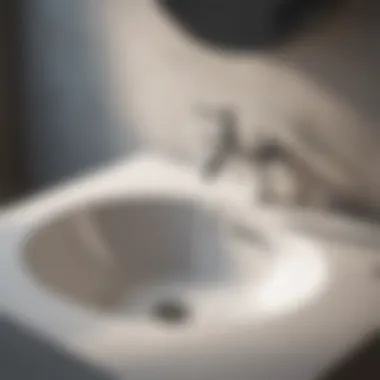
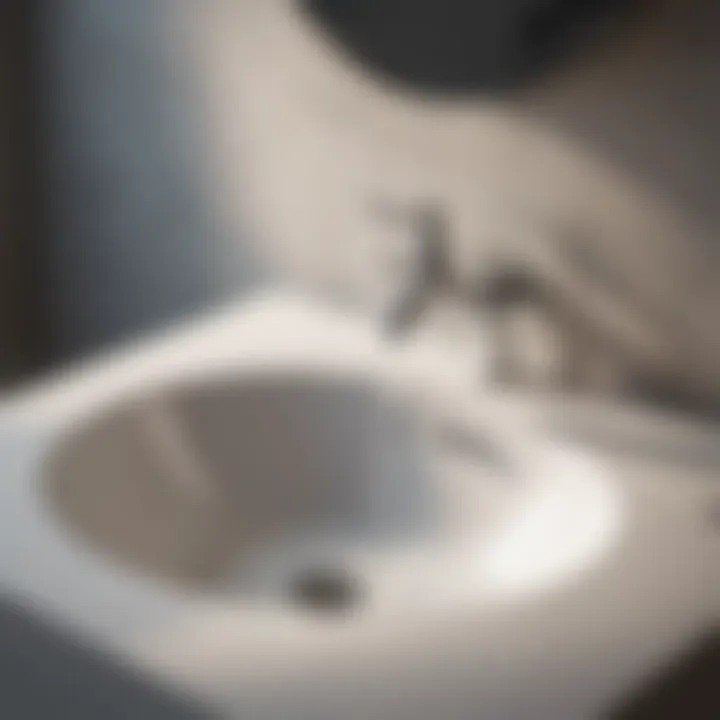
Preface to Baking Soda and Vinegar
In the realm of home maintenance, few substances are as undervalued yet so remarkably effective as baking soda and vinegar. These ubiquitous pantry staples are not just ingredients for your next bake-off but potent allies in the battle against clogged bathroom drains. Understanding the significance of these two common household items sets the stage for effective household management tasks.
When faced with a stubbornly clogged drain, many homeowners often default to chemical-laden solutions that promise instant relief. However, turning to baking soda and vinegar not only offers a natural, eco-friendly approach to unclogging but also minimizes exposure to harsh chemicals that can be harmful both to our health and the environment.
The Chemical Properties of Baking Soda
Baking soda, or sodium bicarbonate, is a white crystalline powder that has been used for centuries for its versatile properties. It's mildly alkaline, which means it can neutralize acids. This characteristic is particularly useful when dealing with clogs, as many organic substances that lead to blockages release acids.
When baking soda encounters water, it dissolves and begins to react with acids, breaking them down efficiently. This means that when poured down the drain, it starts to loosen debris and grease, gradually aiding in the unclogging process. Its abrasive texture also contributes to this effect, helping to remove grime that might be sticking to the sides of pipes, an added boon during the cleaning process.
The Role of Vinegar in Cleaning
Vinegar, on the other hand, is an acidic solution, predominantly composed of acetic acid. This property enables it to cut through and dissolve buildup effectively, whether it's soap scum or mineral deposits. When vinegar is introduced to a drain with baking soda, it initiates a dynamic chemical reaction that releases carbon dioxide gas.
This reaction is not just entertaining; it helps to dislodge clogs by creating bubbles that agitate the contents of the drain, clearing away trapped debris. This reaction not only consumes the physical blockages in your drain, but also leaves behind a fresh, invigorating scent.
In summary, when baking soda and vinegar unite, they create a formidable duo in the fight against drain clogs. Their combined effects result in a thorough cleaning without the adverse side effects of synthetic cleaning solutions. By relying on these natural ingredients, homeowners not only restore functionality to their drains but contribute positively to the sustainability of their household practices.
Step-by-Step Guide to Using Baking Soda and Vinegar
In tackling bathroom drain blockages, utilizing baking soda and vinegar emerges as a naturally effective approach that resonates well with many homeowners. This simple yet potent combination not only offers a reliable solution to clogs, but also fosters a deeper understanding of cleaning techniques that rely on everyday household items.
The great part is that these ingredients are commonly found in kitchens, meaning homeowners won't need to rush to the store for specialized cleaning products, which can often contain harsh chemicals detrimental to both the environment and personal health. Let’s delve into the intricate steps of employing this method effectively.
Preparation for the Process
Before diving into the unclogging procedure, preparation is key. Having the right tools and supplies on hand can make the operation smoother. Here’s what you’ll need:
- Baking soda: The unsung hero acts as a mild abrasive and deodorizer.
- Vinegar: A natural acid that helps to break down tough grime and debris.
- Hot water: Essential for flushing away the remnants after the reaction.
- A cup (or container): For measuring and pouring.
Start by clearing the area around the drain. It's wise to remove any visible loose debris and hair from the drain's opening, since this might inhibit the effectiveness of the baking soda and vinegar combo. A little tidy-up goes a long way in achieving better results.
Applying Baking Soda to the Drain
When you are set for action, the first step is to pour a generous amount of baking soda directly into the drain. About a half cup should suffice. As you do this, make sure you're taking care not to spill it everywhere. It’s not only awkward but creates more mess to clean up later.
Baking soda does not dissolve immediately; instead, it starts to settle in the drain. It’s like softly whispering to your pipes, gently calling them to respond. Patience is a virtue in this step.
Adding Vinegar: The Next Step
Once the baking soda is in place, it's time to introduce the vinegar. The ratio should be roughly equal to the amount of baking soda—again, a half cup should do. For a lively twist, warm up the vinegar slightly before pouring. This can help enhance the reaction, giving it a little pep.
As you pour the vinegar, you will notice fizzing and bubbling. This is a great sign; it means the ingredients are kicking into action, tackling the buildup and blockage with gusto.
The Reaction Process Explained
The fizzing action occurs due to the chemical reaction between baking soda and vinegar. Baking soda, scientifically known as sodium bicarbonate, is a base, while vinegar is acetic acid. When mixed, they create carbon dioxide gas – which is visible as those bubbles fizzing away. This reaction creates a physical agitation that effectively loosens the debris lodged within the pipes.
It's crucial to let this reaction sit for about ten to fifteen minutes. This waiting period grants the mixture ample time to cut through the clogs. During this phase, it helps to distract oneself; perhaps take a brief moment to sip your tea or check a few notifications on your phone. It’s not always easy to resist the urge to continuously monitor the process, but patience is paramount here.
Flushing the Drain with Hot Water
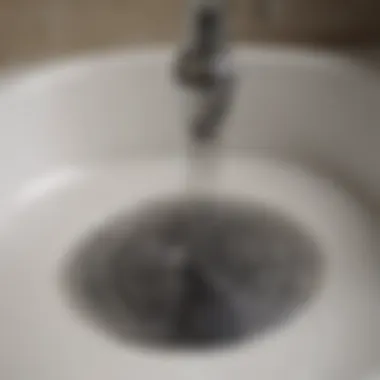
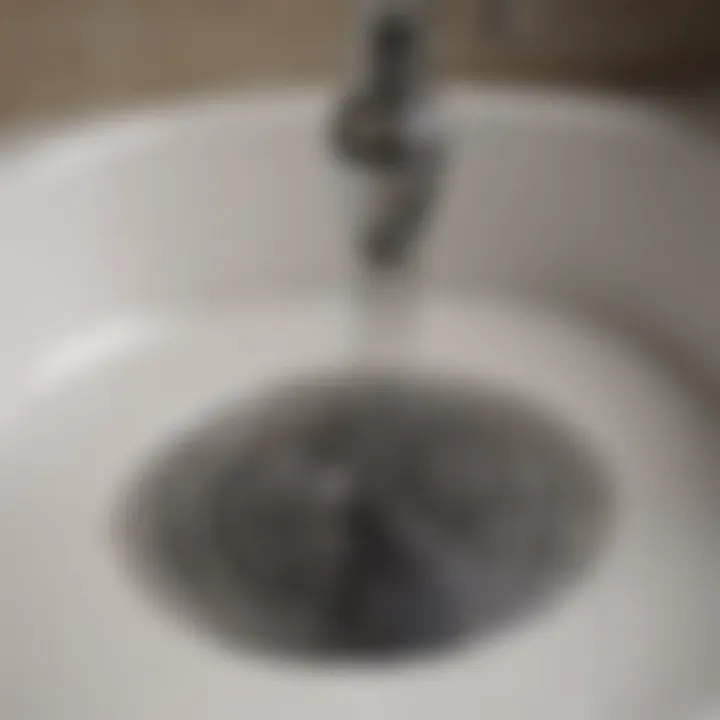
After you've allowed the mix to work its magic, it’s time to flush everything down the drain with hot water. Boiling water is ideal, but water that's near boiling is effective too. Carefully pour the hot water to avoid splashing, and keep an eye on whether water drains smoothly.
If your drain is clear, give yourself a pat on the back! You’ve just employed a natural method to combat clogs and saved yourself a trip to the store or a pricey plumber’s bill. In case the water still hangs around stubbornly, you might need to repeat the process once or twice with fresh baking soda and vinegar.
Using baking soda and vinegar to unclog your drain is not just about fixing the current issue; it's about arming yourself with knowledge for future plumbing problems. The upkeep of drains can make a noticeable difference in overall plumbing health and maintain a cleaner, fresher home.
"Every drain deserves a little TLC with baking soda and vinegar."
By familiarizing yourself with this effective technique, you not only enhance your cleaning repertoire but also adopt a more sustainable way of addressing home maintenance challenges.
When to Seek Professional Help
When faced with a stubbornly clogged bathroom drain, it can be tempting to keep plunging away, hoping for a miracle. However, there are times when the situation is beyond DIY remedies. Understanding when to enlist the help of professionals is crucial, especially for maintaining the integrity of your plumbing system while ensuring your home remains a comfortable living space.
Persistent Clogs That Resist DIY Solutions
If you've tried the baking soda and vinegar method a couple of times without success, it might signal that the problem is rooted deeper in the plumbing. These persistent clogs can stem from various issues:
- Accumulated Debris: Over time, hair, soap scum, and other gunk can pile up and create a solid mass that's tough to break down.
- Tree Roots: In some cases, tree roots intruding from outside may cause blockage, especially if you have older pipes.
- Pipe Destruction: Years of wear and tear or corrosion can lead to a breakage, transforming a mere clog into a repair job.
If the drain persists in giving you grief after several attempts at clearing it, it's wise to call a plumber. Not addressing such issues promptly can lead to further damage, leading to costly repairs down the line.
Identifying Potential Plumbing Issues
Before you pick up the phone to call in a pro, it's advisable to check for red flags indicating that the problem could go beyond a simple clog.
- Gurgling Noises: If your toilet or sink gurgles after flushing or draining, it might point to deeper plumbing issues, such as blockages in vent pipes.
- Foul Odors: Bad smells can be a sign that stagnant water is trapped somewhere in your plumbing, possibly indicating a severe blockage or a sewage issue.
- Multiple Clogs: If other drains in your home are also acting up, it might suggest a systemic problem rather than an isolated incident.
Having an understanding of these indicators can save homeowners a headache—or two. A small investment in professional plumbing services today can prevent a much bigger problem tomorrow.
In sum, knowing when to seek out a professional is not just about solving the immediate problem; it’s about safeguarding your home's plumbing and ensuring long-lasting functionality.
In the field of plumbing, sometimes you really do get what you pay for. Sure, a lot of tasks can be tackled with a little elbow grease and household items, but if the solution seems to keep slipping through your fingers, do yourself a favor and call in a seasoned expert.
Preventative Measures for Drain Maintenance
Taking a proactive approach to bathroom drain maintenance can save you from the headaches of future clogs. Understanding how to prevent these issues not only extends the life of your plumbing but also improves the overall hygiene of your home. After all, no one wants a bathroom that behaves like it's got a mind of its own.
Regular Cleaning Routines
Frequent cleaning of your bathroom drains is key to maintaining clear flow pathways. Simple yet effective routines can make a world of difference. Consider adopting a weekly habit, where you pour a mixture of baking soda and vinegar down your drains. This helps to clear out minor build-ups without aggressive chemicals. A few tablespoons of baking soda followed by a cup of vinegar usually works wonders. Don't forget to flush with hot water afterward.
Moreover, practice physical cleaning by noticing the visible gunk around the drain area. Hair and soap scum can build up quickly. A good tool to employ is a drain snake or a simple wire hanger to remove larger clogs before they become bigger issues.
Proper Disposal Practices
What you toss down the drain often dictates how well it performs. It's crucial to avoid putting anything that doesn't belong there. Items like cotton swabs, dental floss, and even facial wipes might seem harmless, but they can accumulate quickly. Instead, dispose of such products in a trash bin, and encourage your family to do the same.
In the kitchen, be especially cautious with grease and food scraps. Although it may appear easy to rinse off fats, they solidify and stick to pipes over time. Keeping a small container nearby to collect grease can eliminate the temptation to pour it down the sink.
Utilizing Drain Screens
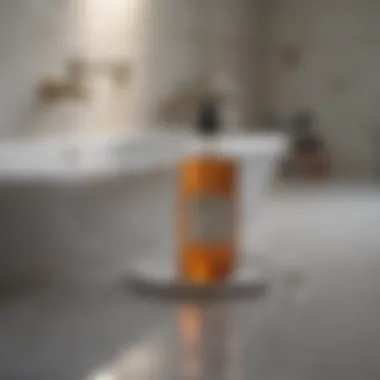
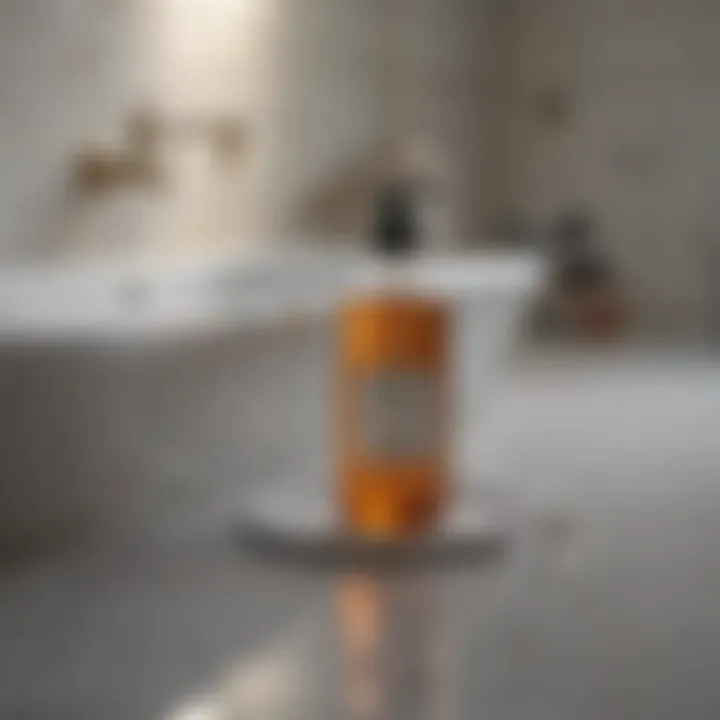
Investing in quality drain screens can be a game changer for your bathroom. These simple devices act as a catch-all for hair and other debris, filtering them out before they can enter the drain. Install them over your bath and sink drains to ensure larger particles don’t get washed away.
Many screens are easy to clean; just pull them out, remove the trapped hair, and rinse. Doing this regularly can significantly reduce the chances of clogs forming in the first place.
"An ounce of prevention is worth a pound of cure." This old saying rings true, especially when it comes to maintaining a clean and functional bathroom drain.
Implementing these preventative measures makes you more equipped to maintain a happy and flowing bathroom. Proactive care avoids the panic of unexpected clogs, ensuring your home remains a pleasant space.
Environmental Benefits of Natural Cleaning Solutions
In today's world, where environmental concerns are at the forefront of everyone’s mind, opting for natural cleaning solutions like baking soda and vinegar presents a practical choice. Not only do these household staples effectively tackle common problems like clogged drains, but they also contribute positively to the ecosystem. By examining the advantages offered by these natural ingredients, we can see how they align with a growing trend toward healthier, more sustainable living.
Reducing Chemical Usage in Homes
Using baking soda and vinegar as cleaning agents significantly cuts down on the use of harsh chemicals that can harm the environment. Many traditional drain cleaners contain toxic substances that can end up in our water systems, posing a risk to aquatic life. By relying on baking soda and vinegar, homeowners can achieve the same level of cleanliness without these harmful impacts. For instance:
- Baking Soda: This naturally occurring compound is safe for both your plumbing and the water supply, as it biodegrades easily and doesn’t contribute to pollution.
- Vinegar: Besides being an excellent cleaning agent, vinegar’s acetic acid is derived from natural sources, making it a much more eco-friendly option.
Furthermore, the simple act of replacing commercial cleaners with these natural alternatives leads to fewer chemical containers in landfills. That’s a win-win for Mother Earth.
Sustainability Considerations
Sustainability is not just about what we consume, it’s about how we choose to maintain our homes. Natural cleaning solutions like baking soda and vinegar are not only effective but embody principles of sustainability:
- Minimal Environmental Footprint: The production of non-toxic cleaning solutions requires less energy and resources. This means fewer emissions and a lower overall impact on the planet.
- Promoting Biodiversity: Using these natural ingredients helps preserve the biodiversity in our ecosystems. Toxic chemicals can cause long-term damage to various species, while baking soda and vinegar have little to no ecological footprint.
- Cost-Effectiveness: Embracing natural cleaners also helps households save money. Baking soda and vinegar are easily accessible and inexpensive, proving that sustainable choices don’t have to break the bank.
"Switching to natural cleaning solutions not only protects the environment but also fosters a healthier home for your family."
In summary, embracing natural cleaning methods aligns with a larger movement toward environmental consciousness and sustainability. With baking soda and vinegar, not only do we unclog drains effectively, but we also contribute to a cleaner, safer planet for future generations.
Ending: Embracing Natural Solutions for Home Maintenance
In today’s fast-paced world, where practicality meets environmental consciousness, choosing natural solutions for maintaining our homes has become imperative. This article has demonstrated that you don’t need to rely solely on harsh chemicals to solve common household issues like clogged drains. Baking soda and vinegar, two ubiquitous kitchen staples, present a simple yet effective blend for handling such challenges. By embracing these natural alternatives, homeowners can achieve not only a cleaner drain but also contribute to a more sustainable environment.
The techniques discussed here offer a multi-faceted approach to drain maintenance. For one, baking soda and vinegar work exceptionally well together due to their contrasting properties. [Baking soda] is a mild alkaline that can dissolve greasy messes, while vinegar’s acidic nature helps in breaking down the buildup of grime and hair in pipes. This dual-action not only unclogs but helps maintain the drain for the long haul, thus saving time and money for homeowners.
Moreover, mastering these techniques empowers individuals, turning an often frustrating problem into a manageable task. It serves as a gentle reminder that innovation does not always equate to complexity; sometimes the best solutions are rooted deep in simplicity and availability.
"A small change can make big waves." Using ingredients you might already have in your pantry minimizes waste and contributes to a less toxic household.
Recap of Effective Techniques
Now that we've dissected the art of using baking soda and vinegar for unclogging, let’s recapitulate the essential steps involved:
- Preparation: Clear any visible debris from your drain. A good starting point is to remove any hair or soap scum lingering on the surface.
- Baking Soda Application: Pour a generous amount of baking soda directly into the drain. This sets the stage for the next step.
- Introducing Vinegar: Follow the baking soda with vinegar. The fizzing reaction helps loosen any stubborn debris.
- Reaction Time: Allow the mixture to sit for a while. Ideally, about 30 minutes can promote effective breakdown.
- Flushing with Hot Water: Finally, rinse the drain with hot water to clear out the dislodged gunk.
Having laid this groundwork, you can now tackle the next clog with confidence.
Encouraging Sustainable Practices at Home
Engaging in sustainable cleaning practices goes beyond unclogging drains; it forms a foundation for more significant lifestyle changes. Integrating natural solutions like baking soda and vinegar not only improves home maintenance but also sparks broader eco-friendly habits.
Considering the environmental footprint of commercially produced cleaning products, opting for non-toxic methods appears to be a responsible choice. Many household cleaners contain harsh chemicals that contribute to air and water pollution. By shifting towards natural products, individuals can reduce their chemical intake, thereby benefiting both their health and the planet.
Some ways to promote sustainable practices include:
- Educating family members about the benefits of using natural cleaning solutions.
- Incorporating more DIY cleaning recipes that leverage safe ingredients.
- Encouraging proper waste disposal, reducing the likelihood of clogs in the first place.
Ultimately, each small effort stacks up to a more significant change. Not only does this foster a cleaner home, but it also cultivates awareness of our collective impact on the environment.



